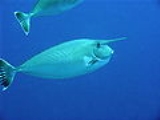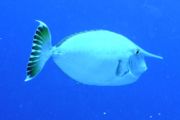
Whitemargin unicornfish
Encyclopedia
The whitemargin unicornfish (Naso annulatus) is a tropical fish found throughout the Indo-Pacific
. It can reach a length of 100 cm making it one of the largest members of the family
Acanthuridae
.

is black surrounded by a white margin. It is often found in large schools
off tropical reefs and feeds on zooplankton
. The fish has two scutes on the left side. These are found on the caudal peduncle near the tail.
Indo-Pacific
The Indo-Pacific is a biogeographic region of the Earth's seas, comprising the tropical waters of the Indian Ocean, the western and central Pacific Ocean, and the seas connecting the two in the general area of Indonesia...
. It can reach a length of 100 cm making it one of the largest members of the family
Family (biology)
In biological classification, family is* a taxonomic rank. Other well-known ranks are life, domain, kingdom, phylum, class, order, genus, and species, with family fitting between order and genus. As for the other well-known ranks, there is the option of an immediately lower rank, indicated by the...
Acanthuridae
Acanthuridae
Acanthuridae is the family of surgeonfishes, tangs, and unicornfishes. The family includes about 80 species in six genera, all of which are marine fish living in tropical seas, usually around coral reefs...
.

Description
It is brown in color and has a distinguishing "nasal" protrusion. The tailTail
The tail is the section at the rear end of an animal's body; in general, the term refers to a distinct, flexible appendage to the torso. It is the part of the body that corresponds roughly to the sacrum and coccyx in mammals, reptiles, and birds...
is black surrounded by a white margin. It is often found in large schools
Shoaling and schooling
In biology, any group of fish that stay together for social reasons are said to be shoaling , and if, in addition, the group is swimming in the same direction in a coordinated manner, they are said to be schooling . In common usage, the terms are sometimes used rather loosely...
off tropical reefs and feeds on zooplankton
Zooplankton
Zooplankton are heterotrophic plankton. Plankton are organisms drifting in oceans, seas, and bodies of fresh water. The word "zooplankton" is derived from the Greek zoon , meaning "animal", and , meaning "wanderer" or "drifter"...
. The fish has two scutes on the left side. These are found on the caudal peduncle near the tail.

